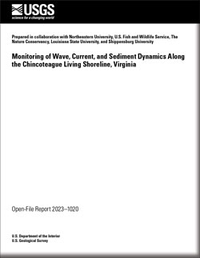Monitoring of Wave, Current, and Sediment Dynamics Along the Chincoteague Living Shoreline, Virginia
Links
- Document: Report (3.22 MB pdf) , HTML , XML
- Data Releases:
- Download citation as: RIS | Dublin Core
Abstract
Nature-based features, also called living shorelines, are increasingly applied in coastal protection and restoration. However, the processes and mechanisms (feedbacks and interactions) of wave attenuation, current velocity change, and sediment deposition and erosion along the living shoreline remain unclear, thus limiting the adaptive management of living shoreline restoration projects for coastal shoreline resilience under future storm conditions. In this study, wave, current, and sediment dynamics along the Little Toms Cove living shoreline, Chincoteague National Wildlife Refuge, Virginia, a low wave energy environment, were investigated during a 2-month winter period in 2019 to examine the effects of living shoreline structures on shoreline protection and oyster habitat enhancement. It was found that wave attenuation by the living shoreline structures (oyster castles or constructed oyster reefs) is dependent on water depth, wind speed, wind direction, and local bathymetry. Analysis of observed data indicate that the oyster castles along the Little Toms Cove living shoreline play a limited role in wave attenuation in this low wave energy environment. During the 2-month winter period, wave energy was attenuated by 39.7 percent when oyster castles were emergent or slightly submerged with southwest winds. In contrast, when the oyster castles were fully submerged, wave energy behind the oyster castles increased by 38.6 percent. The construction of oyster castles affected circulation patterns with increase or decrease in velocity at nearshore waters protected by the castles depending on locations of measurements in relation to the oyster castles. Bottom shear stress analysis indicates that tidal currents play a larger role than waves on shoreline and marsh edge erosion along the Little Toms Cove shoreline during the 2 months of field monitoring. The oyster castles protecting the marsh edge and tidal flat from erosion resulted in higher fine sediment concentration in the water column landward of the castles because more sediment was retained in the lee side of the castles. It is important to maximize sediment within the wetlands and adjacent mudflats behind the oyster castles. Erosion from the marsh edge and interior serves as the major source of sediment for this wetland system due to the limited sediment supply in Assateague Channel. Furthermore, it was found that the oyster castles along the Little Toms Cove living shoreline were inundated more than 60 percent of the time, leading to the enhanced oyster habitat as evidenced by suitable velocity (less than 10 centimeters per second) and mean grain size (less than 0.08 millimeters) for oyster feeding and the increased oyster shell density and growth in the intertidal zone protected by the castles than in the control area. More field data (for example, concurrent monitoring of sediment concentration and salinity) over other seasons (for example, summer) could help examine the long term and combined engineering and ecological benefits of living shoreline restoration projects under seasonal and enhanced future storm conditions.
Suggested Citation
Wang, H., Chen, Q., Wang, N., Capurso, W.D., Niemoczynski, L.M., Zhu, L., Snedden, G.A., Holcomb, K.S., Lusk, B.W., Wilson, C.A., and Cornell, S.R., 2023, Monitoring of wave, current, and sediment dynamics along the Chincoteague living shoreline, Virginia: U.S. Geological Survey Open-File Report 2023–1020, 32 p., https://doi.org/10.3133/ofr20231020.
ISSN: 2331-1258 (online)
Study Area
Table of Contents
- Acknowledgments
- Abstract
- Introduction
- Methods
- Results
- Discussion
- Summary
- References Cited
- Appendix 1
| Publication type | Report |
|---|---|
| Publication Subtype | USGS Numbered Series |
| Title | Monitoring of wave, current, and sediment dynamics along the Chincoteague living shoreline, Virginia |
| Series title | Open-File Report |
| Series number | 2023-1020 |
| DOI | 10.3133/ofr20231020 |
| Publication Date | April 13, 2023 |
| Year Published | 2023 |
| Language | English |
| Publisher | U.S. Geological Survey |
| Publisher location | Reston, VA |
| Contributing office(s) | New York Water Science Center, Wetland and Aquatic Research Center |
| Description | Report: viii, 32 p.; 2 Data Releases |
| Country | United States |
| State | Virginia |
| Other Geospatial | Assateague Bay, Chincoteague National Wildlife Refuge, Little Tom's Cove |
| Online Only (Y/N) | Y |


